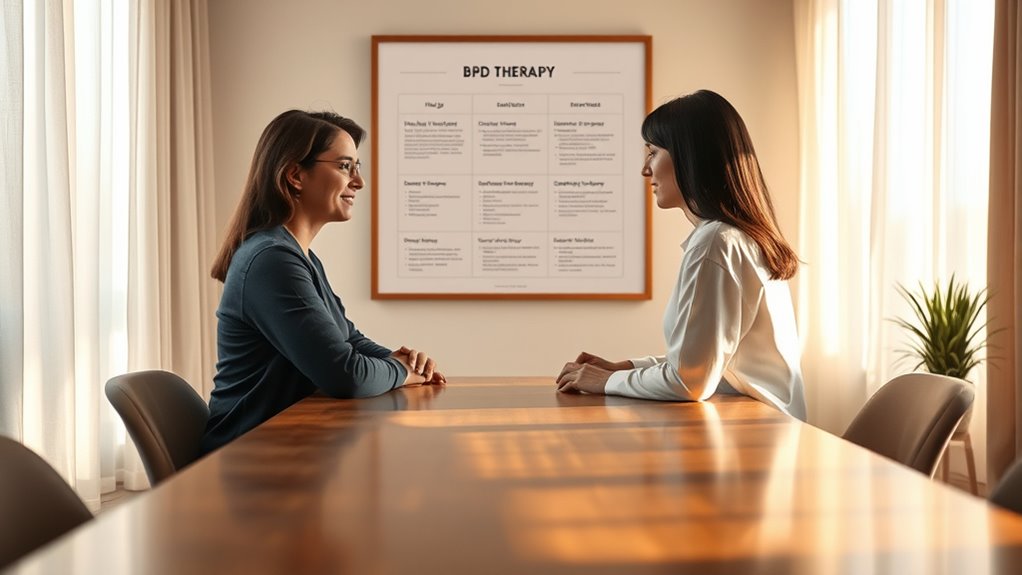There are several effective therapies for borderline personality disorder, including Dialectical Behavior Therapy (DBT), which focuses on mindfulness and emotional regulation, and schema therapy, targeting deep-rooted patterns. Group therapies and mentalization-based approaches help improve relationships and self-understanding. During crises, support from crisis teams and medications can provide short-term relief. A structured Care Programme Approach organizes ongoing care, while emerging therapies like neurofeedback and mindfulness offer new ways to manage symptoms. Keep exploring to find what might work best for you.
Key Takeaways
- Evidence-based psychotherapies for BPD include Dialectical Behavior Therapy (DBT), Mentalization-Based Therapy (MBT), and schema therapy.
- DBT focuses on mindfulness, emotional regulation, distress tolerance, and interpersonal skills with proven reductions in self-harm and emotional instability.
- Structured group therapies enhance emotional stability and interpersonal functioning through peer support and shared learning.
- Crisis management involves community crisis teams and short-term medications to manage acute symptoms, with medications used adjunctively.
- Emerging therapies like virtual reality, neurofeedback, and mindfulness-based apps offer additional tools for emotional regulation and resilience.
Psychotherapeutic Approaches for BPD

Psychotherapeutic approaches for BPD include several evidence-based treatments designed to address the complex emotional and relational challenges associated with the disorder. One key method is Dialectical Behavior Therapy (DBT), which helps you develop skills in mindfulness, emotional regulation, and distress tolerance.
Mentalisation-Based Therapy (MBT) focuses on improving your ability to understand your own and others’ thoughts and feelings, fostering healthier relationships.
Schema therapy targets deeply rooted maladaptive schemas formed during childhood, aiming to restructure these negative patterns.
These approaches are supported by research, showing significant reductions in symptoms and improvements in interpersonal functioning.
Dialectical Behaviour Therapy (DBT)

Dialectical Behavior Therapy (DBT) was developed by Dr. Marsha Linehan specifically for treating BPD. It focuses on teaching skills in emotional regulation, distress tolerance, mindfulness, and interpersonal effectiveness. You’ll participate in weekly individual therapy sessions, group skills training, and receive 24/7 phone coaching to help apply skills in real-life situations. DBT emphasizes validation of your experiences while encouraging change through dialectics—balancing acceptance and growth. Additionally, DBT incorporates remote hackathons to foster continuous learning and skill development for clinicians and patients alike. Research shows that DBT markedly reduces self-harm, suicidal behaviors, and emotional instability in people with BPD. Long-term engagement can lead to sustained symptom remission and better overall functioning. Incorporating evidence-based practices such as DBT is essential for effective treatment of BPD. Ongoing research and AI safety measures contribute to improving the delivery and effectiveness of therapies like DBT, ensuring they remain adaptable to evolving clinical needs. Advances in clinical research continually support the refinement and personalization of DBT approaches to better serve individual patient needs. Moreover, understanding the importance of risk management helps enhance treatment outcomes and patient safety in therapy.
Schema and Group Therapy Options

Have you considered how targeted group therapies can support your journey with BPD? Schema therapy, including group formats, offers a promising approach to addressing deep-rooted patterns.
In structured group sessions, you’ll work on:
- Modifying maladaptive schemas developed early in life
- Achieving emotional stability and reducing emotional swings
- Changing behaviors driven by core maladaptive patterns
- Benefiting from peer support and shared learning
A supportive environment enhances emotional regulation by fostering safe spaces for vulnerability and self-awareness. Additionally, research highlights the importance of cybersecurity vulnerabilities during online therapy sessions, emphasizing the need for secure communication platforms.
Research shows that group schema therapy can be effective as a standalone or complementary BPD treatment, especially in outpatient settings. It’s a cost-effective option that promotes long-term improvements, helping you manage symptoms by targeting the underlying emotional and behavioral roots. Additionally, understanding emotional changes during pregnancy can help tailor therapy approaches to better support emotional regulation. Incorporating therapeutic techniques that focus on emotional regulation can further enhance treatment outcomes. Recognizing the importance of personalized treatment plans can also optimize therapy effectiveness.
Managing Crises and Immediate Support

When managing BPD, knowing how to respond quickly during a crisis can make a significant difference. Immediate support involves contacting crisis services like community mental health nurses, out-of-hours social workers, or crisis resolution teams (CRT). CRTs often prevent hospital admission by providing rapid intervention during psychiatric emergencies such as suicide attempts. Short-term medication, like tranquillizers, can help calm intense mood swings for up to 7 days. If symptoms become life-threatening or safety is at risk, hospital admission or detention under the Mental Health Act may be necessary, although efforts are made to keep stays brief. Accessing helplines like the 988 Lifeline, Crisis Text Line, or local emergency services ensures you get prompt help when needed. Recognizing the importance of crisis intervention can improve outcomes and reduce the need for hospitalization. Additionally, understanding the effectiveness of immediate support options can help individuals recover more quickly from crises and maintain stability. Being aware of local healthcare resources can also facilitate timely assistance during emergencies. Moreover, engaging in preventative strategies, such as regular therapy sessions and medication management, can reduce the severity and frequency of crises over time. Utilizing Gold IRA strategies can also serve as a long-term financial safety net during periods of personal or economic crisis.
Medication and Pharmacological Strategies

Medications aren’t specifically approved for treating BPD itself, and guidelines advise against relying on them as the main approach. Instead, doctors often prescribe psychotropic drugs to manage co-occurring issues like depression or anxiety. While helpful for these conditions, medications have limited evidence supporting their direct effectiveness on BPD symptoms. Glycolic acid benefits such as exfoliation and collagen stimulation are unrelated to BPD treatment but exemplify how targeted therapies can improve skin health.
Medication’s Role and Limitations
While medications are commonly used to manage co-occurring conditions associated with borderline personality disorder (BPD), they aren’t considered primary treatments for the disorder itself. You should know that no medication is officially licensed specifically for BPD, and guidelines advise against relying on medication alone.
Instead, medication is often used to address issues like depression, anxiety, or mood swings. Short-term tranquilizers or sleeping pills may help during crises but only for a week. Medication management can be complex, requiring careful assessment of risks and benefits.
Be aware of these points:
- Medication doesn’t directly treat BPD symptoms.
- Side effects can occur, requiring careful monitoring.
- Efficacy for BPD itself is limited.
- Therapy remains the core treatment, with medication as an adjunct.
- Proper gear shifting techniques can help manage physical comfort and safety during cycling.
Medication’s role is supportive, not curative.
Treating Co-occurring Conditions
Managing co-occurring conditions in individuals with BPD often involves pharmacological strategies, although these are typically used alongside psychotherapy rather than as standalone treatments. Medications like mood stabilizers, antipsychotics, and antidepressants may be prescribed off-label to help control symptoms such as mood swings, impulsivity, or psychosis linked to co-occurring conditions like depression or bipolar disorder. Gold IRA considerations include understanding potential interactions and long-term effects of medication use. Short-term use of tranquilizers or sleeping pills can be helpful during crises, usually for up to seven days, to calm acute symptoms. While medications are valuable for managing specific issues, they aren’t considered primary treatment for BPD itself. Regular monitoring for side effects and ongoing discussion about treatment effectiveness are essential to guarantee safe and effective management of co-occurring conditions alongside other therapies. Additionally, digital literacy programs can support seniors in understanding medication instructions and recognizing side effects, contributing to safer pharmacological management. Incorporating evidence-based guidelines can further optimize medication use and improve overall treatment outcomes. Employing a comprehensive approach that includes psychiatric evaluation can help tailor medication plans to individual needs and maximize benefits.
The Care Programme Approach (CPA)

The Care Programme Approach (CPA) provides a structured framework to coordinate care for individuals with moderate to severe Borderline Personality Disorder (BPD). It guarantees a thorough and personalized approach to treatment.
Here’s how it works:
- You start with a detailed assessment of your mental health, social situation, and support needs.
- A care plan is developed tailored to your specific circumstances, addressing your unique challenges.
- A care co-ordinator, often a social worker or nurse, is assigned to be your main contact, facilitating communication among your healthcare providers.
- Regular reviews are scheduled to monitor your progress, update your care plan, and make treatment adjustments as needed.
This process helps you stay engaged in your recovery and ensures your care remains responsive to your evolving needs.
Self-Help and Support Strategies

Managing emotional triggers is key to maintaining stability, so pay attention to early signs like anger or anxiety.
Building a strong support network with loved ones and community resources can provide ongoing encouragement and understanding.
Educating yourself about BPD and practicing self-help techniques can empower you to handle challenges more effectively.
Managing Emotional Triggers
Have you ever noticed early signs of emotional overwhelm, like anger or dissociation? Recognizing these emotional triggers is key to managing them effectively. Once you’re aware, you can implement coping skills to prevent escalation.
Here are some helpful strategies:
- Practice mindfulness to stay grounded and observe your feelings without judgment.
- Use relaxation techniques like deep breathing or progressive muscle relaxation.
- Maintain a routine to create stability and reduce stress.
- Engage in activities like listening to music or exercise to shift focus and release tension.
Building Support Networks
Building a strong support network is an essential step in managing BPD symptoms and emotional triggers. Connecting with loved ones, community resources, and mental health groups offers crucial help when you face challenges. These support systems provide emotional backing and practical assistance, helping you feel less isolated. Engaging in self-help strategies like exercise, journaling, or relaxation techniques can also reinforce your resilience. Recognizing early signs of overwhelm, such as anger or dissociation, allows you to activate your coping skills promptly. Remember, support isn’t just about seeking help—it’s about building relationships that nurture your well-being. Accessing crisis helplines like the 988 Lifeline offers immediate help during severe distress, ensuring you’re never alone in your journey.
| Support System | Benefits |
|---|---|
| Loved ones | Emotional comfort, understanding |
| Community resources | Practical help, social connection |
| Support groups | Shared experiences, coping strategies |
Emerging and Alternative Therapies

Emerging and alternative therapies for BPD are expanding beyond traditional approaches, offering new avenues for emotional regulation and symptom management. These innovative options include:
Emerging therapies like VR, neurofeedback, and mindfulness expand options for managing BPD effectively.
- Virtual reality therapy, which immerses you in controlled environments to practice coping skills.
- Neurofeedback, helping modulate brain activity linked to emotional dysregulation.
- Mindfulness practices like meditation and yoga, improving emotional stability and reducing impulsivity.
- Smartphone app-based interventions that support ongoing emotional regulation outside therapy sessions.
These approaches aim to complement existing treatments, providing personalized and accessible options.
As research advances, therapies like virtual reality and neurofeedback show promise in targeting specific brain functions, while mindfulness remains a powerful tool for fostering emotional resilience.
Together, these emerging therapies expand your possibilities for managing BPD symptoms effectively.
Frequently Asked Questions
What Type of Therapy Works Best for BPD?
You’re wondering which therapy works best for BPD. Based on evidence, Dialectical Behavior Therapy (DBT) is highly effective, especially for reducing self-harm and suicidal behaviors. It helps you learn emotional regulation skills.
Mentalisation-Based Therapy (MBT) and Schema Therapy are also beneficial, particularly for specific symptoms or severe cases.
Often, combining therapies tailored to your needs provides the best outcome, so discuss options with your mental health professional.
What Are the 3 C’s of BPD?
You might think knowing the 3 C’s of BPD isn’t enough, but they’re key. Crisis involves urgent symptoms like self-harm, requiring immediate support.
Control is about building emotional regulation skills to handle intense feelings.
Change focuses on long-term efforts to reshape maladaptive patterns.
Recognizing these helps you and your therapist tailor strategies, making management more effective and empowering you to build resilience and recovery over time.
What Is the Best Treatment for BPD in the US?
You’re wondering about the best treatment for BPD in the US. Dialectical Behavior Therapy (DBT) stands out as the most effective, evidence-based option. It helps reduce self-harm and suicidal behaviors and has high remission rates over time.
You’ll find it widely recommended by experts, including SAMHSA, and often combined with group schema therapy. While medications can help with co-occurring issues, specialized psychotherapies like DBT are your best bet for addressing BPD itself.
What Is Group Therapy for Borderline Personality Disorder?
Think of group therapy for BPD as a supportive crew steering through rough waters together. You share experiences, learn coping skills, and build connections in a safe space.
This approach often includes exercises, role-playing, and feedback to boost your interpersonal skills and emotional stability. It’s a powerful complement to individual therapy, helping you feel less isolated and more resilient as you work through your challenges with peers who understand your journey.
Conclusion
Exploring BPD treatments is like charting a course through a complex maze—you have many paths to explore. With the right combination of therapies, support, and self-care, you can find your way toward stability and growth. Remember, each step you take is a building block in your journey to understanding and managing your condition. Stay hopeful and persistent—your path to healing is uniquely yours, and brighter days are within reach.









